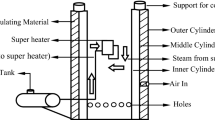Abstract
This work addresses the rural-based chulha (stove) fabrication with less smoke emission. Many traditional cooking techniques used in Indian villages are inappropriate and cause environmental and health hazards like respiratory and vision problems as well as monetary loss. The main objective of this work is to design a stove that overcomes these problems. Emphasis has been made to increase the thermal efficiency of the stove and reduce smoke emission. Here, the focus is to incorporate proper supply of air to the burning chamber for clean burning and ensure primary and secondary combustion. Air is supplied for two purposes; these are primary and secondary combustion. Primary combustion is held in the fuel holder where fuel is burnt by the direct supply of preheated air. Secondary combustion takes place at the top of the burning chamber by burning the smoke that is produced during the primary combustion. This results in reduction of smoke and also ensures clean burning of the fuel. Moreover, refractory materials have also been used to reduce the heat loss. The materials utilized for building this model are locally available and these are low cost. The experiment has been carried out in three stages in terms of each prototype model where the modification is done on the predecessor. The effort has been made to maintain a proper balance between the efficiency of the stove and the low smoke production tendency of the stove. Experiments have been performed in each of the prototype for finding the thermal efficiency.







Similar content being viewed by others
References
India Cookstoves and Fuels Market Assessment, Dalberg Global Development Advisors, Feb 2013
A.K. Quinn, N. Bruce, E. Puzzolo, K. Dickinson, R. Sturke, D.W. Jack, S. Mehta, A. Shankar, K. Sherr, J.P. Rosenthal, Energy Sustain. Dev. 46, 1–10 (2018). https://doi.org/10.1016/j.esd.2018.06.011
R.S. Patil, Y.H. Shindey, A.B. Pandita, Optimisation and development of solid biomass burning cookstoves. Int. J. Chem. Phys. Sci. 2(Special Issue) (2013), ISSN: 2319-6602
M.V. Rawlani, V.B. Muley, A.Y. Aware, A.P. Thakkar, M.S. Teli, A.K. Shirsath, Design and fabrication of low smoke multipurpose chulha. Int. J. Res. Adv. Eng. Technol. 3, 92–95 (2012), ISSN: 2455-0876
R.D. Hanbar, P. Karve, National Programme on Improved Chulha (NPIC) of the Government of India: An Overview, Appropriate Rural Technology Institute (ARTI). Energy Sustain Dev (2002)
J.J. Jetter, P. Kariher, Solid-fuel household cook stoves: characterization of performance and emissions. Biomass Bioenergy 33, 294–305 (2009). https://doi.org/10.1016/j.biombioe.2008.05.014
R. Mohan, S. Kumar, Enhancement of thermal efficiency of traditional in Indian cooking furnace (Chulha). Curr. World Environ. 6(1), 61–66 (2011)
P. Scott, Design of a Rocket Stove WA0006, 2016
H.S. Mukunda, S. Dasappa, P.J. Paul, N.K.S. Rajan, M. Yagnaraman, D.R. Kumar, M. Deogaonkar, Gasifier stoves-science, technology and field outreach. Curr. Sci. 98(5), 627–638 (2010)
A.A. Bantu, G. Nuwagaba, S. Kizza, Y.K. Turinayo, Design of an improved cooking stove using high density heated rocks and heat retaining techniques. J. Renew. Energy 2018, 9620103 (2018). https://doi.org/10.1155/2018/9620103
The Insulation Reform, 2018, http://theisnulationreformation.weebly.com/
S. Kavita, P.D. Dethan, P. Jyothi, J. Ajin, Effect of cowdung and coir in strengthening of clay bricks. IRJET 5 (2018), ISSN: 2395-0056
N.A. Hudelson, N.A. Bryden, K.M.D. Still, Global Modeling and Testing of Rocket Stove Operating Variations (Department of Mechanical Engineering, Iowa State University, Ames, IA, 2002)
B. Günther, K. Gebauer, R. Barkowski, M. Rosenthal, C.T. Bues, Calorific value of selected wood species and wood products. Eur. J. Wood Prod. 70(5), 755–757 (2012)
E.A. Emerhi, Assessment of the calorific value of charcoal from Gmelina Arborea (Roxb), Tectona Grandis (Linn) and (Bentham). Glob. J. Sci. Front. Res. D Agric. Vet. 15(2) (2015), ISSN: 2249-4626
N. MacCarty, D. Still, D. Ogle, T. Drouin, Assessing Cook Stove Performance: Field and Lab Studies of Three Rocket Stoves Comparing the Open Fire and Traditional Stoves in Tamil Nadu, India on Measures of Time to Cook, Fuel Use, Total Emissions, and Indoor Air Pollution (Aprovecho Research Center, Cottage Grove, OR, 2010)
Acknowledgements
We like to thank all the faculty members of Chemical Engineering Department for their guidance and help during the preparation of the stove and testing of this model.
Author information
Authors and Affiliations
Corresponding author
Additional information
Publisher’s Note
Springer Nature remains neutral with regard to jurisdictional claims in published maps and institutional affiliations.
Rights and permissions
About this article
Cite this article
Das, B.J., Das, S., Boro, R. et al. Study and Fabrication on Heat Efficient Stove of Low Smoke Emission. J. Inst. Eng. India Ser. E 103, 125–134 (2022). https://doi.org/10.1007/s40034-020-00197-8
Received:
Accepted:
Published:
Issue Date:
DOI: https://doi.org/10.1007/s40034-020-00197-8




